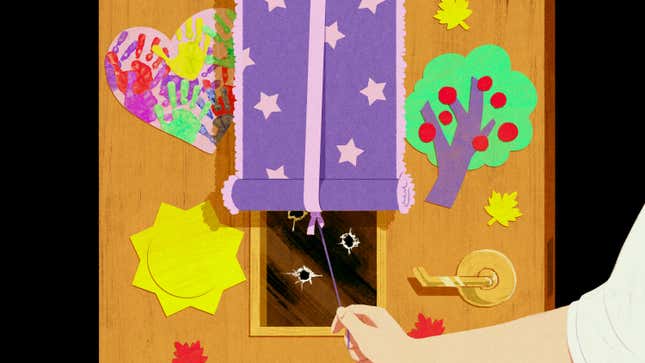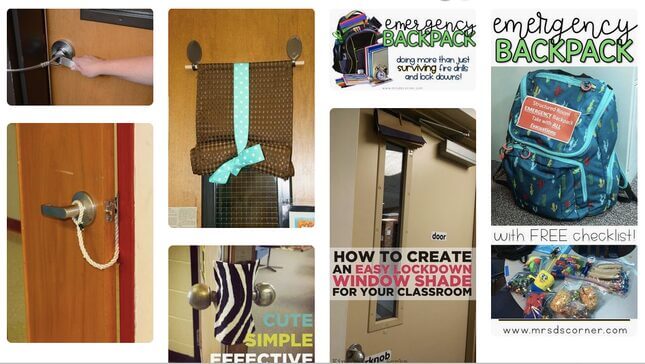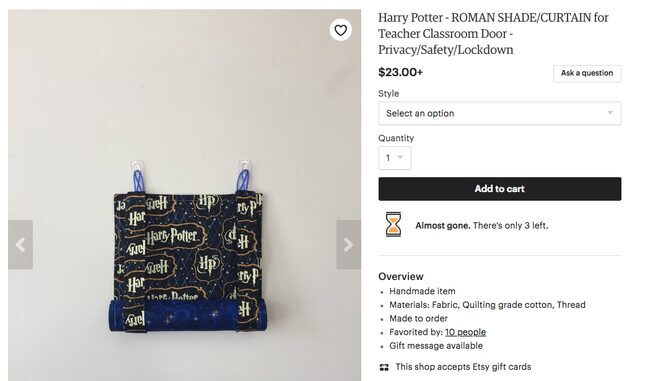
Image: Angelica Alzona/GMG
Teachers on Instagram and Pinterest post the sort of pretty, aspirational content you might find on any highly curated social media feed: Photos of picture-perfect classroom organization and decorations, all of which can sometimes earn teachers tens of thousands of followers or more. In this corner of the internet, there are tips for baking cupcakes or DIYs for the perfect fishtail braid.
But there are also instructions on how to create the best curtains for your classroom window to cover them in case an armed intruder gets into the building. Or a lock smock, a cloth rectangle with bands on each side to fit over door handles, which lets a teacher quickly lock her classroom door without standing outside in the hallway fiddling with keys. Online, teachers trade tips for how to assemble emergency backpacks filled with snacks and quiet sensory toys to “comfort” special needs kids during Code Red drills or lockdowns.
One preschool teacher shared “social stories” on her blog, visual aids to tell young children about what different drills are, from fire drills to intruder alert drills. In a more practical example, another teacher wrote in a blog post a few years ago that she keeps a hammer by her window so she can easily break it if she and her students need to escape.

2018 was the worst year on record for school shootings in the United States, with 97 school shootings according to data compiled by the Naval Postgraduate School’s Center for Homeland Defense and Security. A 2018 report from The Washington Post found that more than 220,000 students have experienced gun violence while at school since the Columbine shooting in 1999. Even though America is a country quietly primed for these tragedies, there’s something about the casual existence of active shooter preparation in these groups of crafty teachers that highlights a disconnect between the brutality of gun violence and the bright, playful aesthetics of the American classroom.
Most Americans would prefer to think of the classroom as a place where childhood is preserved in amber and shared, universal innocence stays forever fixed at a grade level. As gun violence now looms over these classrooms, teachers grappling with this reality are doing so the only way they know how: using the cute, cheery language they fill their lessons with. Seeing the stakes of this reality buried under glitter paint and floral fabric—an aesthetic that refuses to acknowledge this threat with the horror it warrants—evokes a larger refusal in this country to legislatively respond to gun violence. Every small, decorative prevention against a school shooting that hangs in a classroom is ultimately a reminder of America’s resignation in the face of death.
Joe McCormick and Quyen Nicol, two fifth grade teachers who teach in San Marcos, California, who run the Instagram @topfloorteachers, find that the classroom safety content increases after a national tragedy. “It’s the same thing that we talk about in the lunchroom, but now you’re seeing it everywhere because you’re seeing it from teachers who you only connect with online,” McCormick says.
“We’ve been doing this for a while and I definitely feel like the level has escalated,” Nicol, who has been teaching for a decade, says of the safety content. “But you do see a sense of community… what Instagram has done is given a voice to other teachers to feel that sense of camaraderie, like we are all in this together.”
“But it is definitely in the back of your head… you do think: if something would happen we would do that,” she adds.
-

-

-

-

-

-

-

-

-

-

-

-

-

-

-

-

-

-

-

-

-

-

-

-

-

-

-

-

-

-

-

-

-

-

-

-

-

-

-

-










































